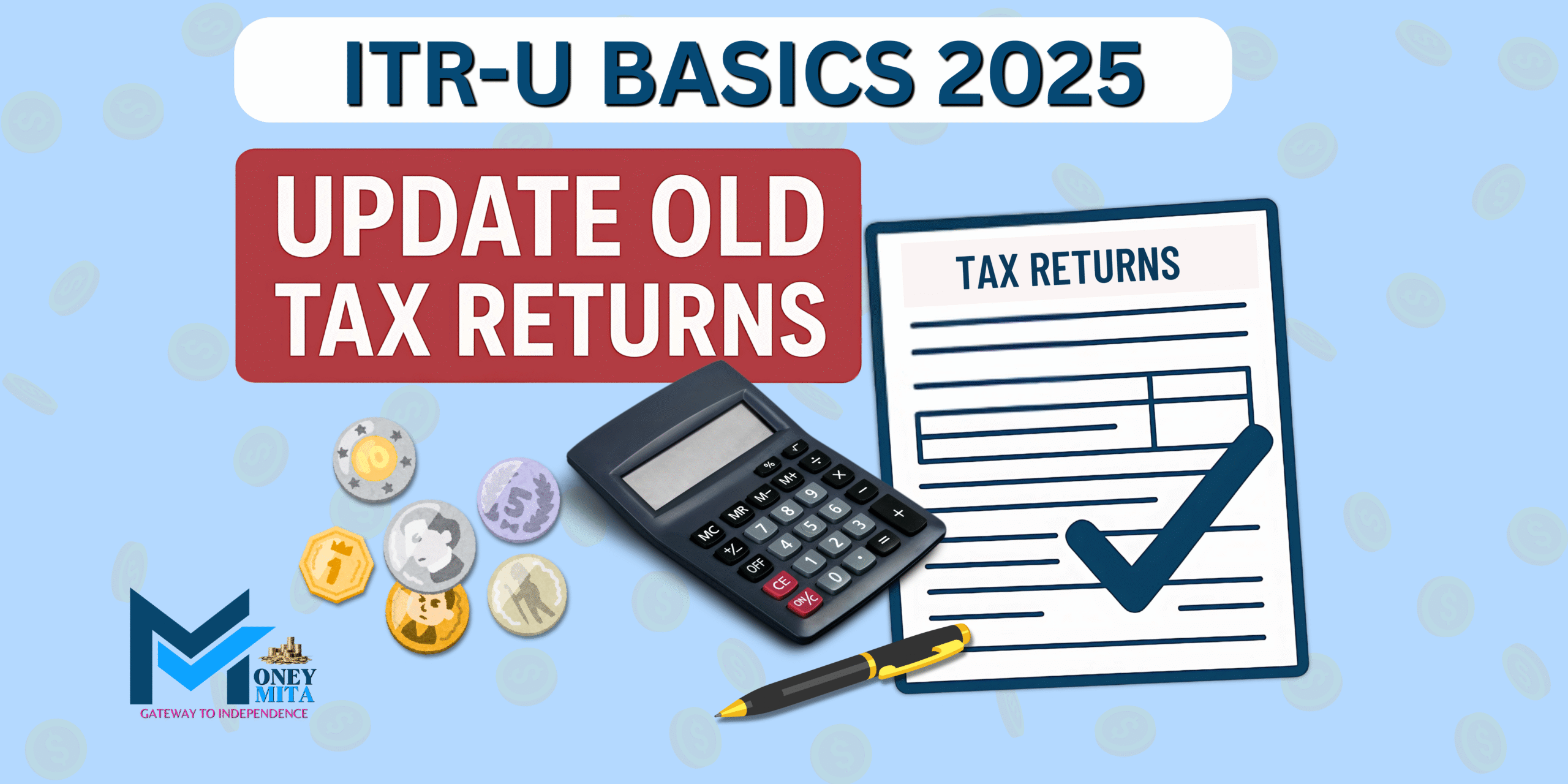Tax filing is a mandatory annual process where individuals and businesses report their income, deductions, and tax liability to the Income Tax Department. Normally, this is done through an original return filed within the prescribed due dates. If missed, one can file a belated return, and if errors are later found, a revised return is possible.
However, these options often left gaps. To address this, the government introduced ITR-U (Income Tax Return – Updated), a powerful tool that allows taxpayers to update old tax returns even after the deadlines for belated or revised returns have passed.
With ITR-U, you can correct mistakes such as unreported income, missed deductions, or wrong tax calculations, and ensure your records are accurate. It not only improves compliance but also reduces future disputes with the tax department.
In 2025, ITR-U remains a step-by-step solution for anyone seeking to stay tax-compliant, allowing for easy and transparent updates of past returns.
In this blog, let’s join to learn ITR-U basics in 2025, who can file ITR-U , Situations where ITR-U cannot be filed and many more.
Table of Contents
ToggleWhat Is “ITR-U Basics-2025”?
ITR-U means “Updated Return.”
Normally, every taxpayer is required to file their original return of income under Section 139(1) of the Income Tax Act, 1961, within the specified due date.
For any assessment year, whether a person has filed an Original Return [139(1)], or a Belated Return [139(4)], or a Revised Return [139(5)], they still have the option to furnish an Updated Return [139(8A)].
Under the Finance Act, 2025, [ Effective from April 1, 2025, AY 2026-27] the time limit for filing ITR-U has been extended to 48 months (4 years) from the end of the relevant assessment year (earlier, it was 24 months). The Updated Return must be filed in the notified form, duly verified, and submitted with all necessary particulars.
SOURCE:–BUDGET 2025 HIGHLIGHTS
🌐https://www.moneymita.com

👉 Quick Eligibility Guide
- If Original ITR [139(1)] → Not filed → Updated ITR can be filed
- If Belated ITR [139(4)] → Not filed → Updated ITR can be filed
- If Revised ITR [139(5)] → Not filed → Updated ITR can be filed
Purpose Of ITR-U
- Disclose additional income missed earlier.
- Correct errors or omissions in past returns.
- Pay your additional tax liability voluntarily before it is detected by the department.
🚫 ITR-U cannot be used to claim extra refunds, declare losses, or reduce tax liability.
In short, ITR-U is a self-correction tool that encourages compliance and lowers the risk of notices or assessments from the Income Tax Department.
Who Can File (ITR-U) an Updated Return?
Universal Filing Rule:
Any taxpayer can file an Updated Return (ITR-U), irrespective of whether an Original [139(1)], Belated [139(4)], or Revised Return [139(5)] was filed earlier for that assessment year.”
A person can file an ITR-U not only for his own income but also for income that is taxable in his name, such as when acting as a representative or when the income of another person is clubbed with his income.
👉 Example:
Miss Kalpana’s taxable income for FY 2023–24 (AY 2024–25) = ₹5,00,000.
Due date for Original Return: 31 July 2024
Due date for Belated Return: 31 Dec 2024
Due date for Revised Return: 31 Dec 2024
Even if Anita misses all of these, she may still file an ITR-U up to 31 March 2029 (i.e., 48 months from AY 2024–25).
Situations Where ITR-U Cannot Be Filed
The Updated Return (ITR-U) allows taxpayers to disclose extra income and pay additional tax. But it is not permitted where it reduces government revenue.
Here’s a checklist of fourteen (14) situations where filing ITR-U is barred:
- NIL Returns
- Loss Returns
- Reduction of Tax Liability or Claiming Refund
- Search and Seizure Cases (Section 132) or Requisition of Books/Assets (Section 132A)
- Survey u/s 133A
- Seizure/Information Related to Another Person
- One-time filing per Assessment Year
- Completed Assessment Cases
- Cases Under Scrutiny or Investigation
- Prosecution Initiated
- Foreign Information Cases (Sections 90/90A)
- Notified Persons or Classes
- New Bar (Finance Bill 2025)
- Time -Barred Cases
Let’s discuss one by one.
- NIL Returns
An ITR showing tax payable as “NIL”, in cases where the total taxable income is below the basic exemption limit for the relevant assessment year.
Example: Rahul, a resident individual (non-senior citizen), has a salary income of ₹1,80,000/- in FY 2023–24 and no other sources of income. He chooses the old tax regime. Since his income is below the basic exemption limit of ₹2,50,000/-, his tax liability comes to nil, and he files a NIL return.
However, the law does not permit filing an Updated Return (ITR-U) for such a NIL return later.
- Loss Returns
An updated return cannot be filed if the total taxable income results in a loss. However, if there is a loss under one head of income but the overall income remains positive, then filing ITR-U is still permitted.
Example A – Allowed
Anita, a resident individual below 60, filed her return for FY 2021–22 (AY 2022–23), showing a total income of ₹12 lakh. Later, she realised she had missed reporting a short-term capital gain of ₹2 lakh on listed equity shares (taxable u/s 111A). In the same year, she also incurred a long-term capital loss of ₹15 lakh from selling immovable property.
Since the long-term capital loss cannot be set off against her other income, it will have to be carried forward. But she can still file an updated return, because her total taxable income (₹12 lakh + ₹2 lakh = ₹14 lakh) remains positive.
Example B – Not Allowed
Biplab, a resident individual below 60, earns a salary of ₹2,00,000/- and incurs a house property loss of ₹5,10,000/- in FY 2023–24 (AY 2024–25). After the maximum set-off of ₹2,00,000/- against salary, he is left with a carry-forward loss of ₹3,10,000/- and no taxable income. Since this is a loss return, he cannot file ITR-U later.
👉 Quick Takeaway:
- Case A (Anita): Total income remains positive despite a loss under one head → ITR-U Allowed.
- Case B (Biplab): Total income is nil with a carry-forward loss → ITR-U Not Allowed.
- Reduction of Tax Liability or Claiming Refund
An Updated Return (ITR-U) is not allowed if it reduces the tax liability or results in a refund.
Example: Ramesh, a resident individual under 60, originally reported ₹6,00,000/- taxable income and paid ₹23,400/- tax under the new regime for FY 2022–23 (AY 2023–24). Later, he finds deductions that would reduce income to ₹4,00,000/-, making tax liability ₹7,800/- to zero due to rebate u/s 87A. ITR-U cannot be used to claim this reduction.
- Search and Seizure Cases (Section 132) or Requisition of Books/Assets (Section 132A)
An Updated Return (ITR-U) is not permitted for any assessment year where a search or requisition action has taken place or any assessment year preceding to such assessment years.
Example: During a search at Mr. Verma’s premises for AY 2024–25, unaccounted cash is found. He cannot later use ITR-U for that year or for the preceding AY, like AY 2023-24.
- Survey (Section 133A)
ITR-U cannot be filed in case of a survey, for any assessment year or any assessment year preceding to such assessment years.
EXCEPTION
If the survey is carried out under Section 133A(2A) for TDS/TCS verification, the ITR-U filing is allowed.
Example: FY 2021–22: Resident Partnership Firm surveyed in February 2022 for stock discrepancies. ITR-U for AY 2022–23 and preceding years is barred.
- Seizure/Information (Section 132 or 132A) Related to Another Person
A person cannot file ITR-U if, during a tax raid on someone else, cash, jewellery, property papers, or documents are found that actually belong to him. In such cases, the person is barred from filing ITR-U based on a notice issued to him for that assessment year and the years before it.
Example: FY 2020–21: Jewellery seized at Mr. Akash’s house linked to his friend Mr. Pawan’s PAN, confirmed in writing by Akash. Mr. Pawan cannot file ITR-U for AY 2021–22 and earlier years.
- One-time filing per Assessment Year
An Updated Return can be submitted only once for a particular AY.
Example: For FY 2022–23 (AY 2023–24), if a resident files ITR-U in February 2025, filing another ITR-U for the same year is not permitted.
- Completed Assessment Cases
If an assessment, reassessment, recomputation, or revision has already been completed or is underway, ITR-U cannot be furnished.
Example: For FY 2022–23 (AY 2023–24), if the Assessing Officer completes the assessment, the taxpayer is barred from filing ITR-U.
- Cases Under Scrutiny Or Investigation
Where scrutiny or reassessment is ongoing under any of the acts like: PMLA 2002, Benami Property Act 1988, Black Money Act 2015, Smugglers & Foreign Exchange Manipulators Act, 1976, and the Assessing Officer (AO) has issued notice to the taxpayer, then the person is barred from filing ITR-U.
Example: A Taxpayer under investigation for alleged foreign exchange violations cannot file ITR-U for that AY.
- Prosecution Initiated
When prosecution has been launched for a particular AY, filing of ITR-U is restricted.
Example: Prosecution for tax evasion initiated for AY 2022–23 prevents ITR-U filing for that year.
- Foreign Information Cases (Sections 90/90A)
If the department receives information about the taxpayer from a foreign government under a Double Taxation Avoidance Agreement (DTAA) OR a Tax Information Exchange Agreement (TIEA), and intimates it by a notice to the person, an ITR-U cannot be filed by the person concerned.
It could include:
- Foreign bank account details – Account holder information, transactions and balances.
- Foreign investment records – Shares, bonds, or other assets held abroad.
- Property ownership abroad – Real estate, rental income details.
- Foreign income – Salary, business income, dividends, or interest earned outside India.
- Beneficial ownership info – If you are a beneficiary of an offshore trust or company.
Example: Swiss authorities share Mr. Raj’s foreign bank account information with the Indian tax department for AY 2023-24; ITR-U cannot be filed for that AY.
- Notified Persons or Classes
If the government notifies specific persons or classes as ineligible, they cannot file ITR-U.
Example: High-risk tax evaders, shell companies, or blacklisted GST taxpayers are barred from using ITR-U.
- New Bar (Finance Bill 2025)
If a show cause notice under section 148A is issued [for reassessment of escaped income], after 36 months from the end of AY, filing ITR-U is barred. The reassessment window will prevail against the updated return.
Exception: But if the officer passes an order under Section 148A(3) within 36 months from the end of AY, saying it’s not a fit case to reopen, ITR-U will prevail against reassessment and can be filed within 48 months.
Example: AY 2021–22: Notice issued on April 1, 2025, → ITR-U barred unless Section 148A (3) order allows filing.
But if the notice is issued on or before March 31, 2025, you can still file ITR-U (subject to other eligibility rules).
- Time-Barred Cases
An ITR-U can be filed within 48 months from the end of the relevant assessment year.
Example: For FY 2021–22 (AY 2022–23), the due date to furnish ITR-U is March 31, 2027. After this, it becomes invalid.
Return Of Income Vs Return of Loss
| PARTICULARS | RETURN OF INCOME | RETURN OF LOSS |
| 1. Definition | Filed when taxable income is positive. | Filed when total income is negative (loss). |
| 2. Relevant Section | Section 139(1) – Return of Income. | Section 139(3) – Return of Loss. |
| 3. Purpose | To report income and pay taxes. | To claim carry-forward of losses (business loss, capital loss, or house property loss). |
| 4. Carry Forward Benefit | Not applicable – since there is no loss to carry forward. | Yes, it allows for the future set-off of eligible losses if filed within the due date. |
| 5. ITR-U Eligibility | Allowed (only as a return of income). | Not applicable – loss returns cannot be filed/updated using ITR-U. |
| 6. Example | Ramesh, a resident individual of less than 60 years of age, earns a salary income of ₹8,00,000/- in FY 2023–24. After deductions, taxable income = ₹6,50,000/-. He files a return of income in AY 2024-25, under the old regime. | Shivani, a resident individual (below 60 years), has a salary income of ₹2,00,000/- and incurs a house property loss of ₹5,10,000/-. After setting off ₹2,00,000/- against her salary, the net loss stands at ₹3,10,000/-. She files a return of loss under Section 139(3). |
Frequently Asked Questions (FAQ)
Q1. Does ITR-U apply to NRIs and foreign income cases?
Ans. Yes—NRIs, residents, firms, companies, trusts, etc., can file ITR-U if eligible. However, if the department has already communicated foreign information under tax-treaty routes (Section 90/90A) for that AY, ITR-U is barred.
Q2. What if I filed a timely loss return — am I still eligible?
Ans. You may file ITR-U only as a return of income (not loss). If it reduces carried-forward losses, depreciation, or tax credits, you must also update the affected subsequent years.
Q3. Can I revise ITR-U after filing?
Ans. No, once filed, ITR-U cannot be revised again.
Q4. Can ITR-U be filed for multiple assessment years together?
Ans. No, ITR-U must be filed separately for each AY. Each filing is independent and subject to eligibility rules.
Q5. What are the Key “Anti Black Money Laws”?
Ans. There are four (4) main anti-black money laws present in India.
A. Smugglers and Foreign Exchange Manipulators (Forfeiture of Property) Act, 1976 (SAFEMA): – It allows the Government to forfeit properties of smugglers and foreign exchange manipulators involved in illegal activities.
B. Prohibition of Benami Property Transactions Act, 1988 (Benami Act): -A property purchased in someone else’s name (benamidar), while the real benefit goes to another person (beneficial owner). Exception: – properties held in the name of close relatives or held in a fiduciary capacity may not be treated as benami.
C. Prevention of Money Laundering Act, 2002 (PMLA): – The process of converting illegal money (“dirty money”) into legal form (“clean money”).
D. Black Money (Undisclosed Foreign Income and Assets) Act, 2015: – It targets undisclosed foreign income and assets held abroad by Indian residents.
Q6. What is DTAA?
Ans. A Double Taxation Avoidance Agreement (DTAA) is a treaty between two countries to ensure the same income is not taxed twice.
Q7. What is TIEA?
Ans. A Tax Information Exchange Agreement (TIEA) allows two countries to share tax-related information to prevent tax evasion.
Q8. How is TIEA different from DTAA?
Ans. DTAA avoids double taxation and gives relief to taxpayers, while TIEA mainly helps governments exchange financial information.
Q9. With whom does India sign DTAA and TIEAs?
Ans. India has signed DTAAs with over 90 countries, including the USA, UK, Singapore, and Mauritius.
India signs TIEAs with low-tax or no-tax jurisdictions (such as Bermuda and the Bahamas), where a DTAA is not required.
CONCLUDING NOTE: –Once you know basics of the Updated Return, the next step is to understand the “Reasons for Updating Return” with proper verification.
Read the 2nd blog post: -“ITR – U 2025: Reasons For Updating Return“

I am a practicing Chartered Accountant, now venturing into content writing. Covering money matters—taxation, finance & financial news—presenting accurate, easy-to-understand insights, combining professional knowledge with a passion for educating readers on managing and understanding their finances better.








